Did you know that the Appleyard duck is one of the best dual-purpose duck breeds?
This rare breed with distinctive qualities originated in England in the 1940s.
This breed has a peaceful and amiable nature. It is famous for producing many eggs and high-quality, lean meat and is a beautiful addition to your flock.
Keep reading to learn about the Appleyard duck breed and how you can raise it on your farm.

Table of Contents
History and Origin
Reginald Appleyard, an expert chicken breeder, developed the Appleyard duck breed in the 1940s in England.
The breed has since then gained popularity in other countries.
Reginald wanted a duck with the ideal proportions of size, attractiveness, and large white eggs.
His quest was successful, as he created a fantastic all-purpose farmyard duck with quality meat and a high egg-laying capacity.
Reginald crossed a variety of breeds to develop the Appleyard duck. They include the following:
- The Mallard
- The Pekin
- The Rouen
He then focused on characteristics like colossal body size, a calm attitude, and powerful maternal instincts.
The Appleyard breed arrived in the US in the 1960s and became publicly available in 1984.
Is This an APA-Recognized Breed?
The APA recognized the Appleyard duck in 2000.
Breed Standard
This domesticated breed is famous for its size, friendliness, and prolific egg and meat production.
Here are some essential components of the Appleyard breed standard.
Body Type
The Appleyard duck has a large, spherical body with a big chest, an erect stance, and a serene, regal demeanor. The duck’s physique is balanced and well-proportioned.
Feathers
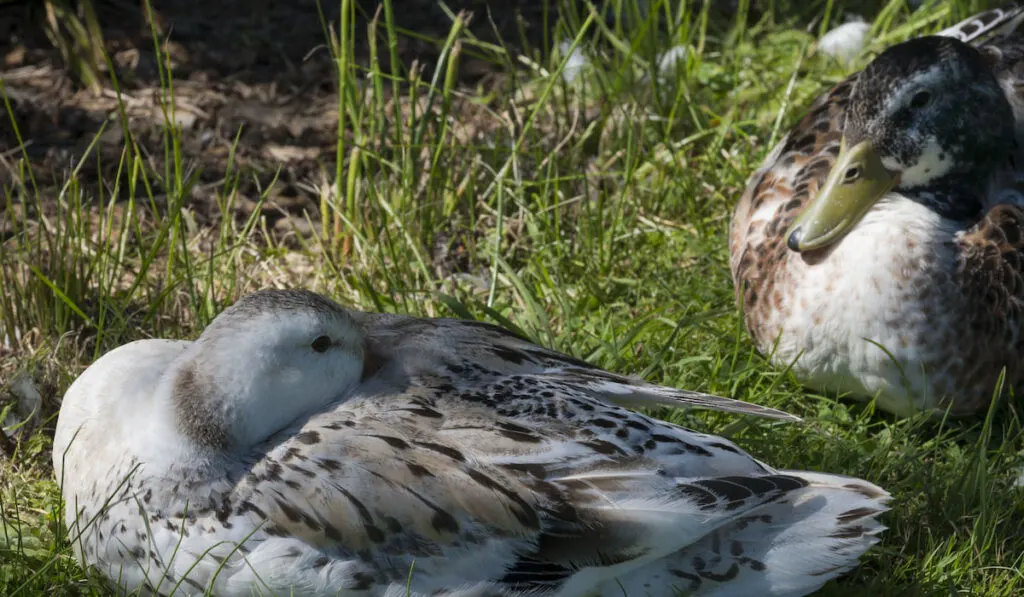
Appleyard ducks have soft, thick, well-spaced plumes devoid of flaws or deformities.
Head and Bill
An Appleyard duck has a head with a broad, rounded crown. The bill is yellow or orange and of medium length.
Legs and Feet
The legs are sturdy, evenly spaced, and proportionate to the torso.
On the other hand, its feet are faultless: webbed and pointed straight ahead.
An Appleyard duck’s legs and feet are yellow.
Plumage Color
This plumage may come in various hues and patterns.
The Appleyard duck’s color variants are khaki, chocolate, black, and blue.
Size, Height, and Weight
The male Appleyard ducks, or drakes, weigh between 7 and 9 pounds (3–4 kg).
Females weigh between 6 and 7 pounds (2.6–3 kg).
Their ducklings attain a market weight of 5–7 pounds (2.3–3 kg) in 8–12 weeks.
Rare Colors
The breed has no documented rare colors.
Temperament/Disposition
Appleyard ducks are peaceful and amiable; hence they are manageable and fun to be around.
Noise Level
Appleyard ducks have a modest noise level. They are quiet compared to other duck breeds.
Despite their amiable demeanor, Appleyard ducks become loud when seeking food or attention.
Appleyard ducks are suitable if you want a docile and not excessively loud breed.
Purpose
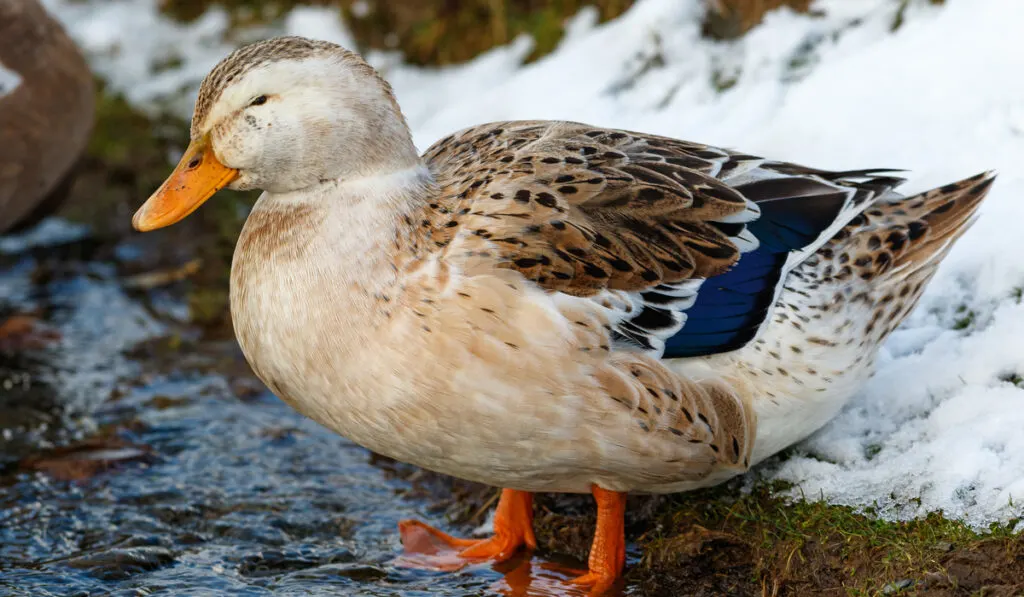
The Appleyard is a dual-purpose breed. It is both an excellent layer and a decent meat bird.
Egg-Laying
Appleyard ducks have an optimum egg-production capacity.
Appleyard ducks can lay up to 260 eggs annually and keep laying all winter.
Meat Production
If you’re considering raising ducks for meat, the Appleyard is an ideal choice. They produce high-quality, lean and tasty meat ideal for domestic consumption.
Other Uses
Besides meat and egg production, you can also raise the Appleyard ducks for the following purposes:
- Pets: Appleyard ducks make good pets due to their docile temperament.
- Ornamental birds: You can also keep them as ornamental birds due to their beautiful looks.
- Source of down feathers: You can use their down and feathers to make pillows, down comforters, and stuffed toys.
Cold and Heat Tolerance
Appleyard ducks are resilient and adaptable. These birds can thrive in diverse conditions if you give them proper care.
They are cold hardy:
- They have a rich plumage that insulates them against the cold.
- They have a fast metabolism that aids body-heat production.
The breed can control its body temperature in hot weather by:
- Panting to increase heat loss.
- Looking for shade or cover to shield them from the scorching sun.
- Swimming or splashing around in a pool or pond.
But to keep your ducks cool and prevent heat stress, provide them with shade and sufficient ventilation.

Sexing (How to Tell Male From Female)
There are several ways to differentiate the male and female Appleyard ducks.
You can tell if a duck is a male or female by looking at its physical and behavioral traits.
Physical Characteristics
Some of the most recognizable physical traits that can help you tell male Appleyard ducks from females include the following:
- Males or drakes are more colorful than females.
- The male’s bodies are larger and more robust compared to the females.
- The Appleyard males have a more prominent head than females.
Behavioral Traits
Some of the behavioral characteristics you can use to tell male Appleyard ducks from females include the following:
- Males exhibit wooing behavior during mating seasons. For instance, they will preen to display feathers.
- Females are more likely to search for food or tend to their eggs or ducklings.
- Males have a low-pitched quack, while females have a louder and softer quack.
Hatching/Raising
If you wish to raise ducks for eggs or meat, go with Appleyard ducks.
Appleyard ducks have good brooding and maternal instincts.
Here are the Appleyard ducks’ hatching and rearing traits:
Brooding
The Appleyard duck’s eggs have an incubation period of approximately 28 days.
As mentioned above, female Appleyard ducks have excellent brooding abilities and maternal instincts.
Appleyard ducks can incubate and hatch their eggs by themselves.
Hatching
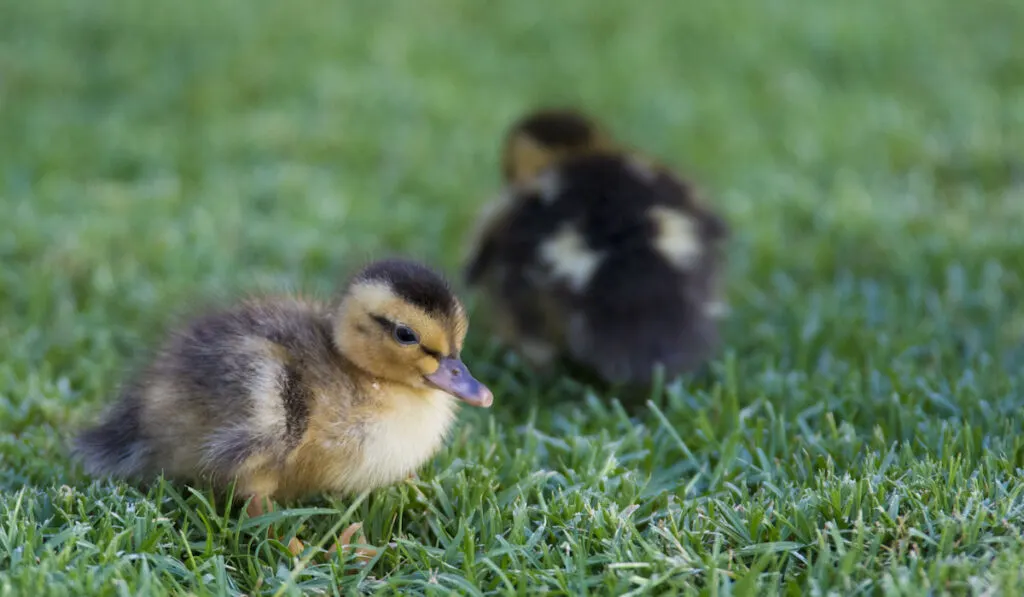
The female duck will tend to the ducklings and keep them safe once the eggs have hatched. After a few days, the ducklings can swim and feed themselves.
Feeding
Feed your Appleyard ducklings premium starter food designed especially for ducks. If keeping them for eggs, gradually transition them over to layer feed as they mature.
If not, you can slowly transfer them to a grower feed.
Shelter
Ensure you provide a secure shelter like a coop or corral to protect your ducks from predators and bad weather. The ducks should have sufficient space to move freely.
And the housing should be well-ventilated.
Health
The Appleyard ducks need routine vet checks to maintain their health. Additionally, keep an eye on their surroundings for proper sanitation and safety.
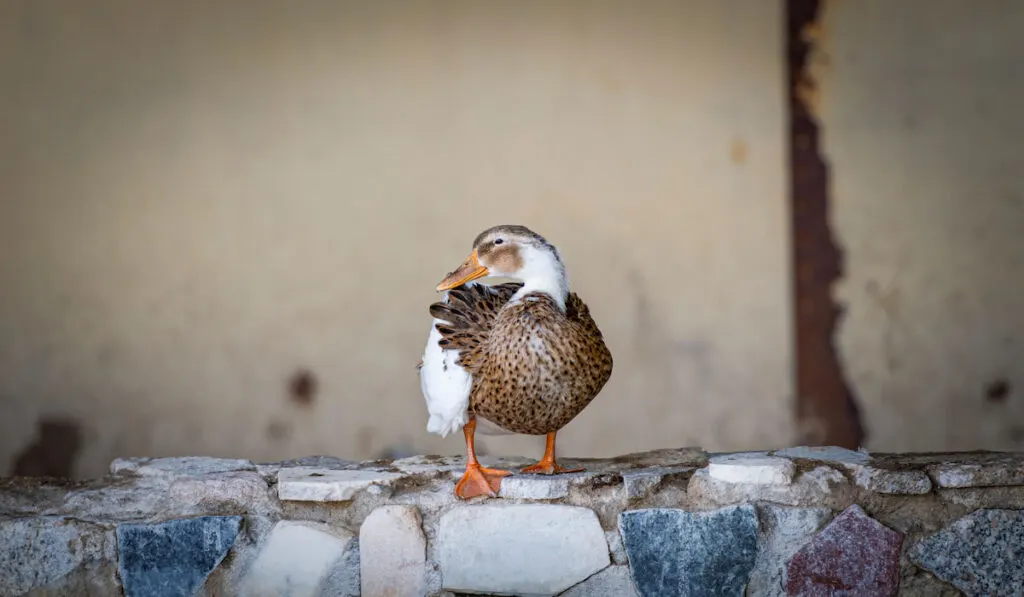
Common Health Issues
Like all domesticated duck breeds, Appleyard ducks experience health problems.
Some of the most common health issues affecting them include the following:
Parasites
Many parasites can infect ducks and cause skin rashes, anemia, and weight loss. They include the following:
- Mites
- Lice
- Worms
Respiratory Infections
The birds can suffer respiratory diseases resulting in coughing, sneezing, and nasal discharge. The most common respiratory infections are these two:
- Newcastle disease
- Avian influenza
Vitamin Deficiencies
The Appleyard ducks require a balanced diet with all essential vitamins and minerals. A vitamin deficiency can lead to issues such as:
- Eye problems
- Skin disorders
- A Compromised immune system
Foot Problems
The Appleyard duck can be susceptible to foot conditions like bumblefoot.
This infection causes pain and difficulty in walking.
Egg-Laying Problems
Like many duck breeds, the Appleyard ducks can encounter egg-laying-related issues. However, these are uncommon or infrequent.
You can lessen the danger of egg-laying problems and other health issues:
Keep your ducks in a clean, dry, and well-ventilated habitat and provide them with a balanced diet.
Also, routine checks with your vet can help identify and address symptoms in time.
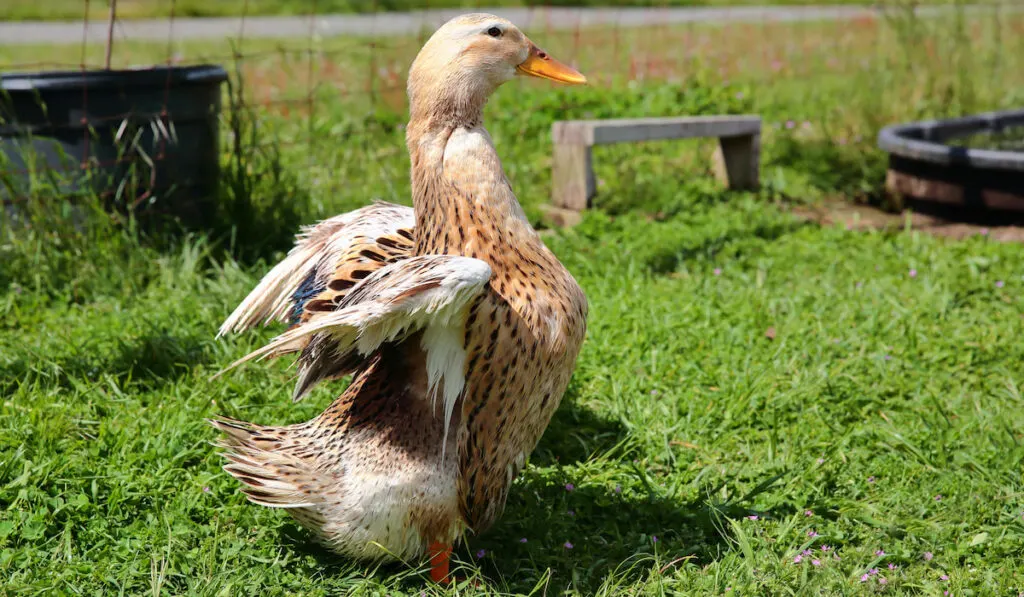
Appleyard Duck Pros and Cons
There are many benefits and drawbacks to raising Appleyard ducks.
Pros
Good Layers
Appleyard ducks are prolific layers.
Hardy
These ducks are a hardy breed; they are adaptable to diverse conditions.
Dual Purpose
You can raise Appleyard ducks for meat and egg production.
Good Foragers
The bird is a skilled forager.
Calm Disposition
Appleyard ducks have a tranquil demeanor. They are a viable option if you want to keep ducks as pets.
Cons
Slow Growth Rate
The Appleyard ducks take longer to mature compared to other species. They are thus less preferable for commercial farmers.
Higher Feed Requirements
Raising the Appleyard ducks can be expensive. They have a higher feed intake than other duck breeds.
Spacious Living Requirements
The Appleyard ducks require a lot of space to wander about and are unsuitable for backyards with limited space.
Susceptibility to Certain Health Issues
The Appleyard ducks are prone to some health problems, as discussed earlier.
Therefore, they need medical attention, making them more expensive to raise.
Similar Breeds
The Appleyard duck is comparable to several different breeds in size, look, and use. Here are a few of them.
Mallard Duck
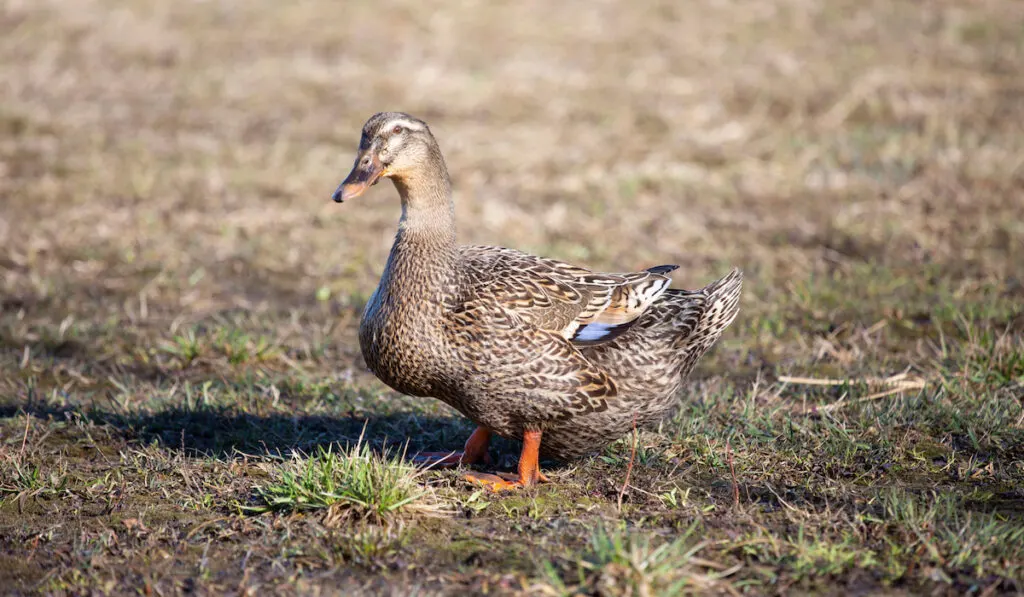
Female Appleyard ducks have mottled brown feathers on their upper back, but female mallards have them all over. Both female Appleyard and mallard ducks have a splash of blue feathers on their wings.
Both Male Appleyard and Mallard ducks have striking, emerald green plumage on their heads.
Pekin Duck
Pekin ducks are white and have a body form similar to the Appleyard ducks. They are famous for their quality meat.
Rouen Duck
The Rouen duck compares to the Appleyard duck in size. Rouens produce meat and eggs and are also docile, like the Appleyard.
Cayuga Duck
The Cayuga duck is a medium-sized breed like the Appleyard. They are also prolific layers.
Welsh Harlequin Duck
This breed is smaller than the Appleyard but similar in demeanor and superior laying prowess. The Welsh Harlequin duck is famous for its distinctive feather patterns.
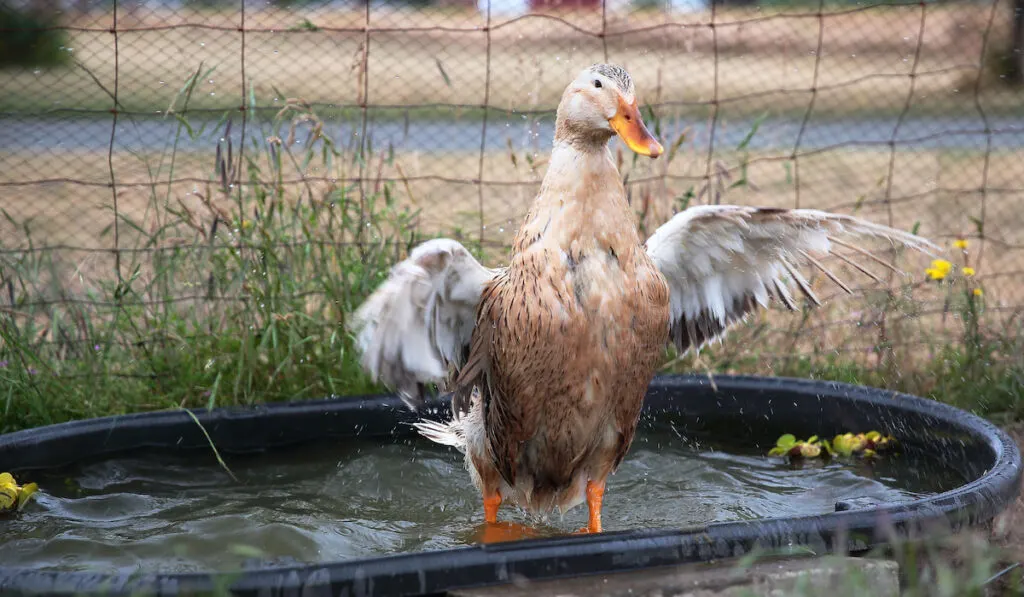
Frequently Asked Questions (FAQs):
The breed originated in England during the 1940s.
The Appleyard ducks can produce about 200–260 eggs annually.
The Appleyard ducks can survive for up to 7 years.
The male Appleyard ducks can weigh up to 9 pounds (4 kg). Their female counterparts can weigh up to 7 pounds (3 kg).
Appleyard ducks want a lot of space to roam, so give them a roomy place to live.
You can feed the birds commercial feed and foraged foods like insects, greens, and grains.
Final Thoughts
Raising ducks can be a pleasurable and enriching endeavor. The Appleyard duck is an ideal choice if you are looking for a dual-purpose breed for your farm.
This breed is highly adaptable, an ideal choice whether you are a homesteader or a large-scale farmer.
Consider the Appleyard duck if you’re thinking about keeping ducks for eggs, meat, or as pets. Ensure they have a safe and secure living space, wholesome food, plenty of water, and necessary vet care.
These insights will help you enjoy raising your feathered friends.
Resources
I wrote this article from my experience raising ducks and the following sources:
- https://livestockconservancy.org/heritage-breeds/heritage-breeds-list/silver-appleyard-duck/
- https://www.tandfonline.com/doi/full/10.1080/17415349.2017.1395304
- https://www.cdc.gov/flu/avianflu/avian-in-birds.htm
- https://vikaspedia.in/agriculture/poultry/general-management-practices-for-chicken-and-ducks/internal-parasites-of-chickens-and-ducks
- https://pubmed.ncbi.nlm.nih.gov/20273809/
- https://www.ncbi.nlm.nih.gov/pmc/articles/PMC7229147/
- https://rosehillfarm.ca/2020/09/04/raising-silver-appleyard-ducks/
- https://www.permaculturenews.org/2013/10/12/ducks-backyard-permaculture-alaska/
